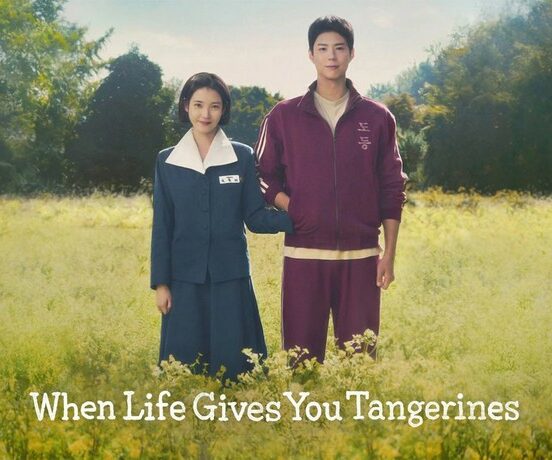From Ddakji to Sky Squid: A Breakdown of Every Challenge in the Series [Spoilers Alert]
Ddakji (딱지): The Paper Tile Game

Ddakji is a traditional Korean game played with two folded paper tiles. The goal is to hit your opponent’s tile with yours hard enough to flip it over. It’s often played by kids and teaches basic skills like timing, aim, and taking turns.
In Squid Game, this childhood game takes on a darker twist. A mysterious man approaches people in debt and invites them to play Ddakji. If they flip his tile, they win ₩100,000. If they lose and can’t pay, they get slapped instead. After playing, they receive a card inviting them to join the secret Squid Game competition.
Ddakji also appears in the team challenge called the Six-Legged Pentathlon. One member must flip a tile to move the team forward in the race.
Fun fact: The red and blue tile choice may remind some viewers of a Korean ghost story where choosing red or blue paper in a bathroom always ends badly,just like in the show.
Dalgona: Carve It Without Cracking It
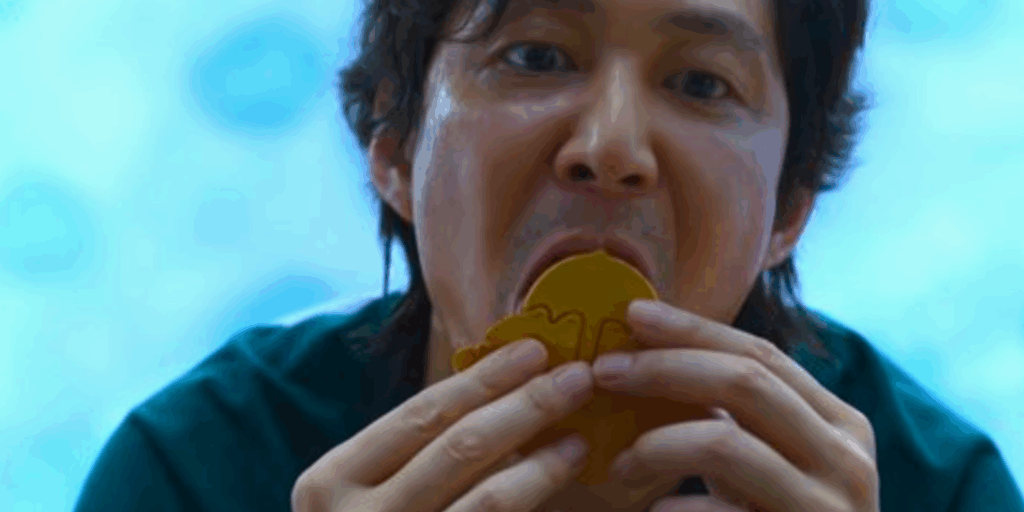
Dalgona, also known as ppopgi, is a sweet Korean treat made from melted sugar and baking soda. In a popular street game, players try to carefully cut out a shape pressed into the candy, like a star or umbrella without breaking it. It’s a fun challenge that’s often rewarded with another piece if done successfully.
In Squid Game, this childhood activity turns bad. Players choose a shape without knowing the rules, then receive a tin with that shape pressed into a dalgona candy and a needle. The goal: carve the shape out without cracking it. If the candy breaks or time runs out, the player is eliminated.
Some shapes are much harder than others. The triangle is the easiest, while the umbrella is the trickiest due to its thin handle. In total, 187 players took part in this game, 79 didn’t make it through.
Not all players stuck to the basic method. Player 456, Gi-hun, started licking the back of the candy to melt it and loosen the shape. Others heated the needle with a lighter to make carving easier.
Though simple in appearance, the game became one of the most intense moments in the series, showing how even the smallest childhood memories can turn into high-stakes challenges.
Tug of War: A Team Game with Deadly Stakes
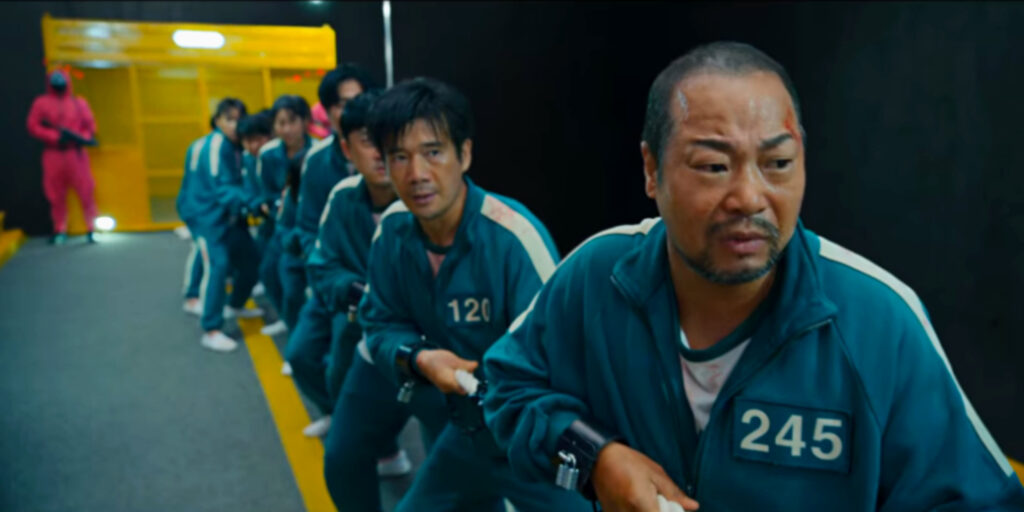
Tug of War, or Juldarigi in Korean, is a traditional team game often played during festivals or school events. Two teams pull on opposite ends of a rope, trying to drag the other team past a center point. It’s all about teamwork, balance, and timing.
In Squid Game, Contestants are split into teams of 10 and chained to a thick rope on two high platforms. Once the game starts, the losing team is pulled off their platform—and falls to their death.
This was the third game in the 2020 Squid Game. A total of 80 players joined, and only half, 40 players survived. Players didn’t know who they would be up against until the match began, making team strategy even more important.
The game didn’t just rely on strength. Seong Gi-hun’s team, for example, used a smart strategy taught by Oh Il-nam (Player 001), which helped them beat a physically stronger team by pulling in rhythm and using footwork.
Tug of War in Squid Game shows how even the most familiar games can turn into life-or-death battles when the rules are changed and when losing isn’t just about pride, but survival.
Red Light, Green Light: Stop Fast or Say Goodbye
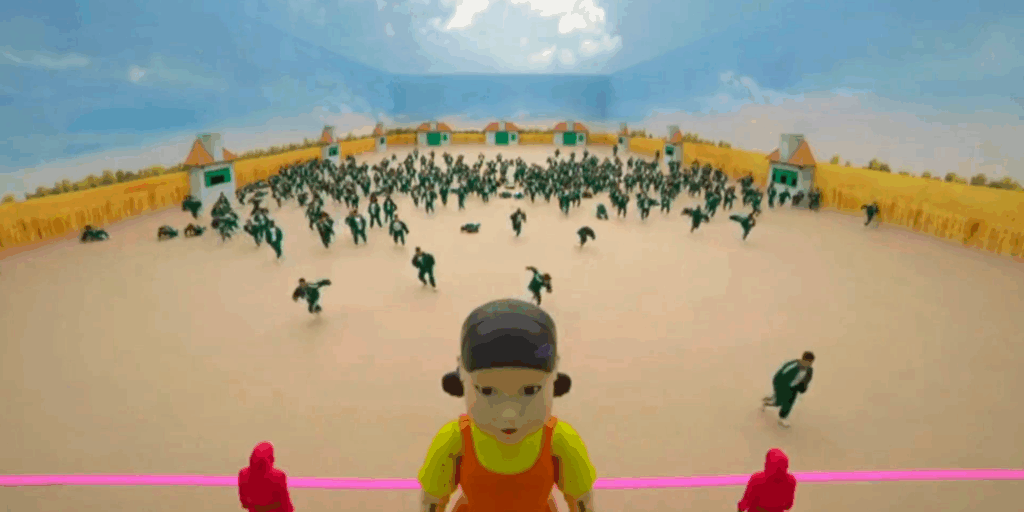
Red Light, Green Light is a children’s game known across many countries. In Korea, it’s called “무궁화 꽃이 피었습니다”, which means “The Mugunghwa Flower has Bloomed.” One person stands at the front while everyone else lines up far away. When the person calls out, players move forward but they must freeze instantly when the caller turns around. If they’re caught moving, they’re out.
In Squid Game, Players must cross a field within five minutes while a giant motion-sensing doll ‘Young-hee’ calls out “Green Light” and “Red Light.” Anyone caught moving when the doll turns around is shot by hidden snipers. The field looks like a fake countryside, but the danger is very real.
The 2020 game started with 456 players. More than half, 255 people were eliminated after being caught moving. Only 201 made it to the next round. In the 2024 version, fewer players were eliminated, partly thanks to smart teamwork and better tactics.
Some players used tricks to stay alive. Oh Il-nam kept a wide stance for better balance. Others hid behind people or moved in single-file lines. A few even crouched low to avoid being seen moving.
Rock Paper Scissors Minus One

Most people know Rock Paper Scissors, a game where two players use hand signs to try to beat the other: rock crushes scissors, scissors cuts paper, and paper covers rock. If both players choose the same thing, it’s a tie.
In Squid Game, a version called “Rock Paper Scissors Minus One” is played outside the main games, with a dangerous twist. Each player uses both hands to play, then removes one after someone calls “minus one.” The winner is decided by the hands that remain. If a player doesn’t take one hand back, they’re disqualified.
In the show, this game was used by a recruiter during a brutal version of Russian Roulette. Two players, Mr. Kim and Woo-seok, were forced to play, and the loser faced a 1-in-6 chance of being shot. After several rounds, the recruiter grew bored and raised the stakes by loading 5 bullets instead of 1.
Mr. Kim eventually lost by not removing one of his hands, choosing to sacrifice himself. The gun fired, ending the game.
Glass Bridge: Step Right or Fall
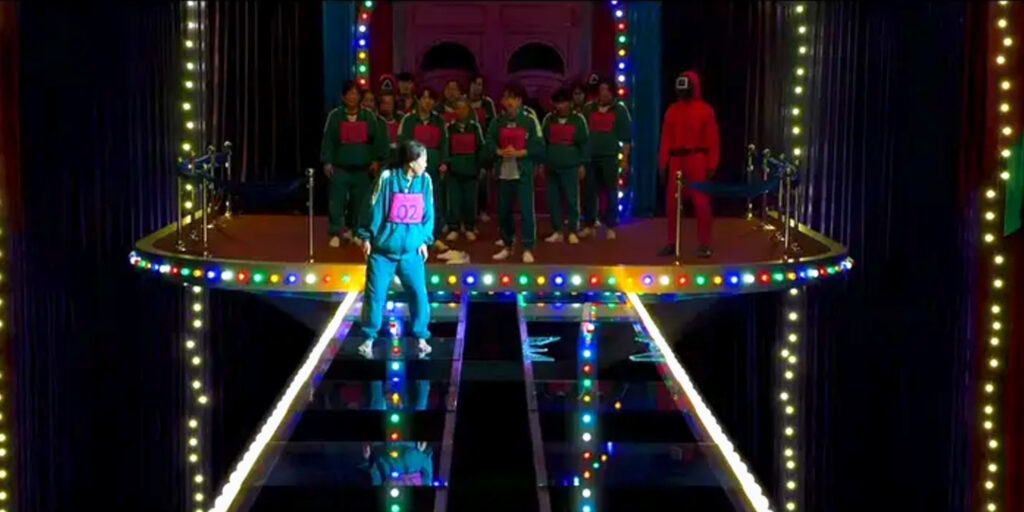
The Glass Bridge game, featured in Squid Game, is based on the Korean children’s game “징검다리 건너기” (Jing-geomdali Keonneogi), where kids hop across stepping stones. But in this version, the stakes are deadly.
In the game, players must cross a long bridge made up of two rows of glass panels. Some panels are made of strong tempered glass, while others are fragile and will shatter under a person’s weight. If a player steps on the wrong one, they fall and are eliminated. The catch? There’s no way to know which panel is safe, unless you’re lucky, clever, or willing to risk someone else’s life to find out.
Before the game began, players had to choose a number from 1 to 16. That number decided the order in which they crossed the bridge. The first players had no clues, while those in the back could follow the safe path, if enough people ahead of them survived long enough to show the way.
Only 3 out of 16 players made it to the other side before the 16-minute time limit ran out. Among the many who didn’t make it were Player 101 (Deok-su), Player 212 (Mi-nyeo), and Player 017 (Do Jung-soo), who had worked in a glass factory for 30 years and tried using his knowledge to survive. In the end, even his expertise wasn’t enough.
Some players tried to outsmart the game by observing the glass or pushing others to go first. One theory said players could tell the difference by sound or reflection, but the Front Man eventually turned off the lights to stop this tactic.
Marbles: A Game of Chance and Choice
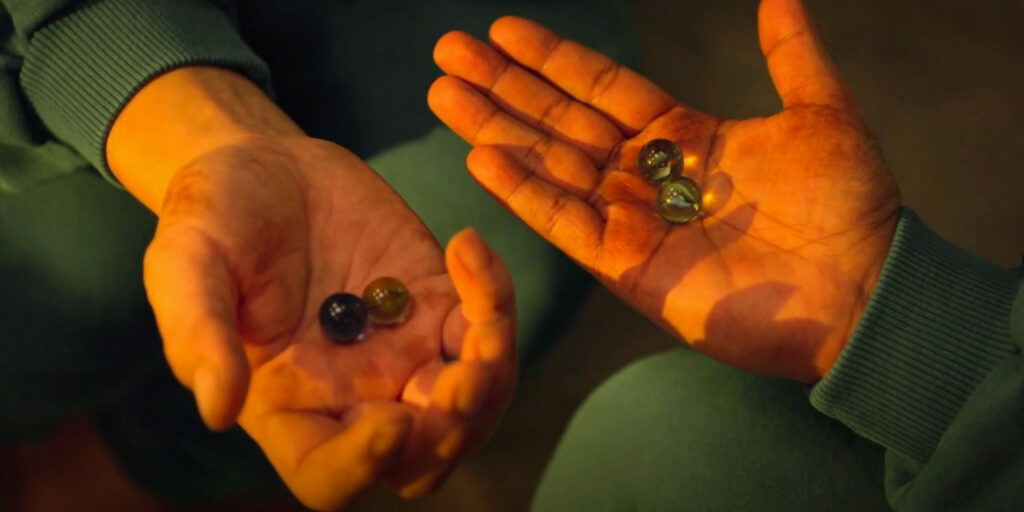
The Marbles game in Squid Game is based on a traditional Korean children’s activity, where players make up their own rules to win their opponent’s marbles. It’s flexible, and creative.
For this round, players were told to pair up. Many chose friends or allies, not knowing they’d soon be playing against each other. Each pair received a bag with 10 marbles per person and had 30 minutes to win all of their partner’s marbles through any game of their choice. The loser was eliminated.
Some chose guessing games, others played simple tosses. A few made emotional sacrifices, letting their partner win on purpose.
A total of 39 players entered the round. In the end, 22 were eliminated, including key characters like Ali Abdul (199), Ji-yeong (240), and Oh Il-nam (001). Only 17 players moved on to the next stage: the Glass Bridge.
One exception was Han Mi-nyeo (212), who survived without playing. Since there was an odd number of players, she didn’t get a partner and automatically advanced.
Though the rules seemed simple, the marbles game tested more than skill, it challenged trust, guilt, and what people were willing to do to survive. In many ways, this was the most emotional and personal round of them all.
Six-Legged Pentathlon: Five Games, One Chance
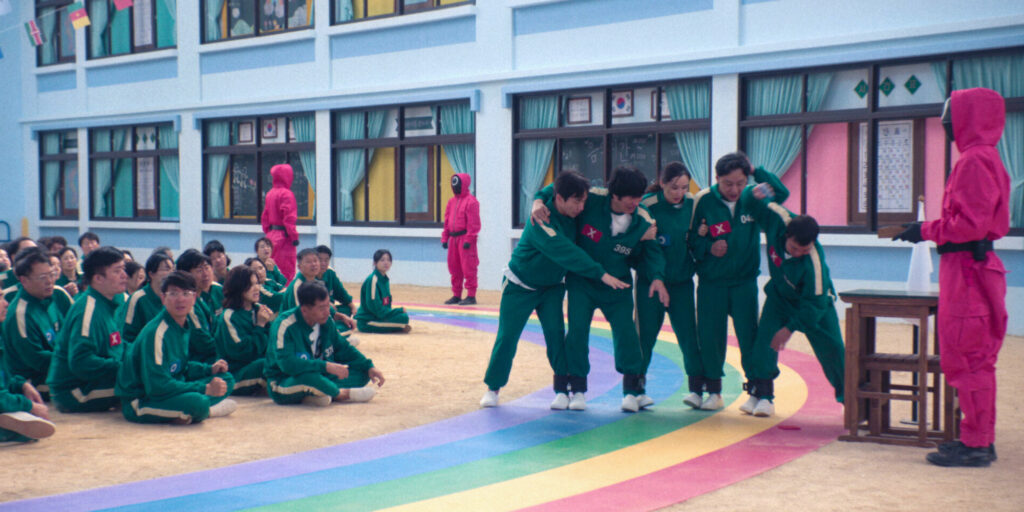
The Six-Legged Pentathlon is one of the most intense team challenges in Squid Game. It’s not just one game, but five mini-games combined into a single race. Inspired by classic Korean playground games, this event pushes both teamwork and time management to the edge.
Players are grouped into teams of five. Their legs are tied together, and they must move as one unit around a circular track. At five points along the track, each teammate must complete a different game:
- Ddakji: Flip a paper tile using another tile.
- Biseokchigi: Hit a stone with another stone while standing behind a line.
- Gonggi: A multi-step catching game using small stones.
- Paengi Chigi: Spin a top using a string.
- Jegi: Kick a small paper shuttlecock (like hacky sack) five times without dropping it.
Each teammate plays one mini-game, and the entire team must finish the course in under five minutes. If any game isn’t completed or if the team doesn’t reach the finish line in time everyone on that team is eliminated.
The event is set in a large indoor arena made to look like a schoolyard, complete with sand, flags, and rainbow-colored tracks. It’s a visually nostalgic setup hiding a brutal truth: delay or failure in any task means death for the whole team.
Some teams coordinated well and passed. Others didn’t make it in time. A few players even got stuck because of teammates struggling with spinning tops or forgetting the rules of childhood games. In total, over 100 players were eliminated during this round including Player 198 and Player 254.
Unlike other games in Squid Game, the Six-Legged Pentathlon is all about timing, memory, and teamwork. You can’t survive it alone even if you’re the best player on the team.
Gonggi: Korea’s Classic Hand Game (Jacks)
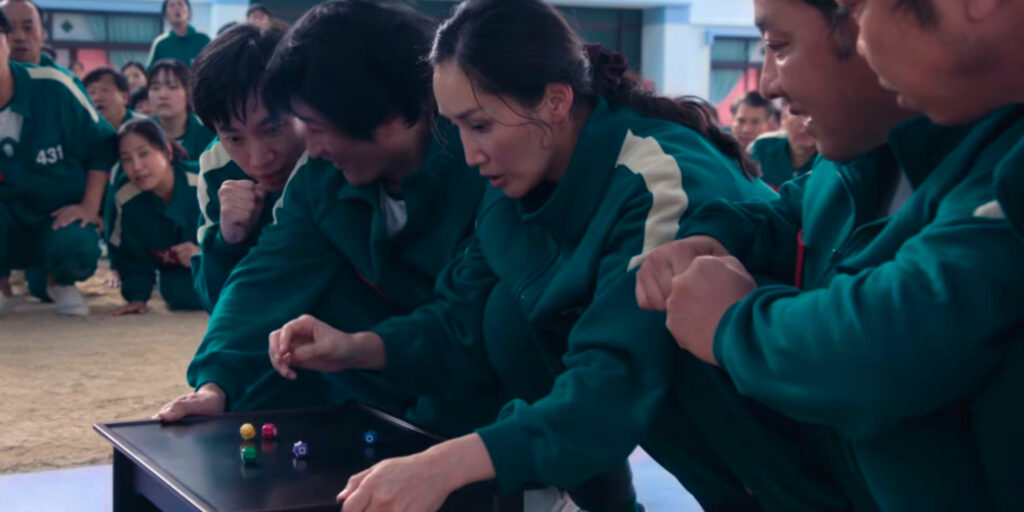
Gonggi, also known as Korean jacks, is a traditional game that tests hand-eye coordination, quick reflexes, and steady timing. It was featured as the third mini-game in the Six-Legged Pentathlon during Squid Game.
Players are given five small plastic stones, usually with tiny pebbles inside for weight. The game is played on a flat surface and becomes harder with each level. The basic idea is to toss one stone into the air, quickly pick up others, and catch the tossed one before it lands.
Here’s how the challenge works:
- Level 1: Toss one stone, pick up the other four—one at a time.
- Level 2: Toss one, then pick up the stones in pairs.
- Level 3: Pick up three, then one.
- Level 4: Toss one, drop the other four, then pick up all four at once.
- Final: Throw all stones into the air, catch them on the back of your hand, then toss them again and catch them in your palm.
Miss a catch at any point? You start over from the beginning.
Biseokchigi: A Classic Korean Target Game
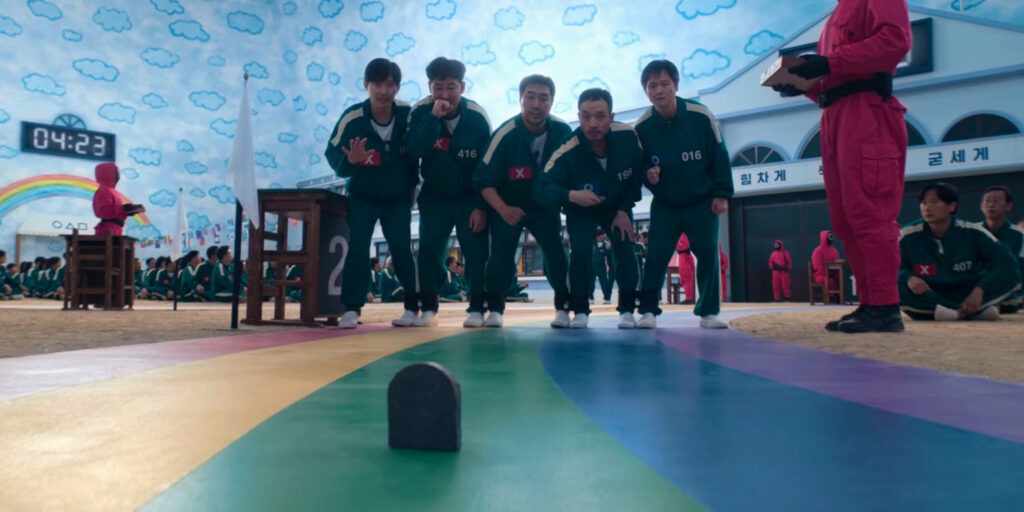
Biseokchigi, also known as Flying Stone, is a traditional Korean game that combines aim, patience, and steady hands. In Squid Game, it appears as the second mini-game in the Six-Legged Pentathlon.
The rules are simple but challenging: a stone slab often called a “tombstone” is placed a few meters away. The player must hit it by throwing a small stone, all while keeping their foot behind a marked line. Crossing the line or missing the shot wastes time, forcing the team to retrieve the stone and try again.
Each attempt counts, especially when the team is racing against a five-minute timer.
Notable players like Park Yong-sik (Player 007) and Se-mi (Player 380) succeeded in this mini-game, while others, including Jang Do-yeong (Player 198), were eliminated after missing their shot.
Paengi Chigi: Spin It to Win It
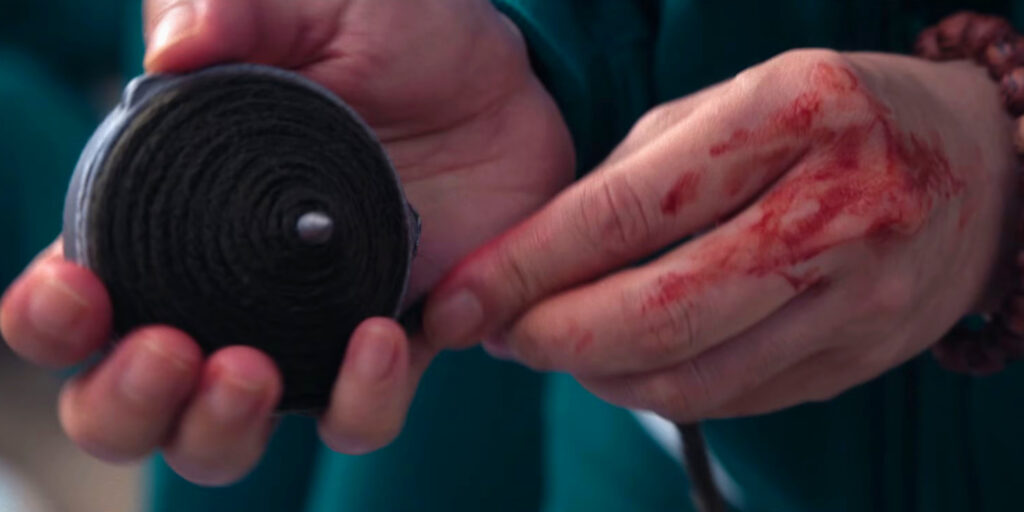
Paengi Chigi, or Spinning Top, is a classic Korean game where success depends on technique and timing. It appeared as the fourth mini-game in the Six-Legged Pentathlon in Squid Game.
To pass, players must wrap a string tightly around a wooden or plastic top and launch it onto the ground. The top must spin smoothly for a few seconds without tipping over. If it falls too quickly, the attempt fails and the team has to retrieve the top before trying again, losing valuable time.
Though it sounds simple, this game can be tricky under pressure. A rushed throw or loose winding often ends in failure.
Notable players who completed this challenge include Player 001 (Hwang In-ho), Player 044 (Seon-nyeo), and Player 343 (Sim Jae-seok). Several others struggled, including Player 098 and Player 330, who were eliminated after failed attempts.
Jegi: Korea’s Hacky Sack Challenge
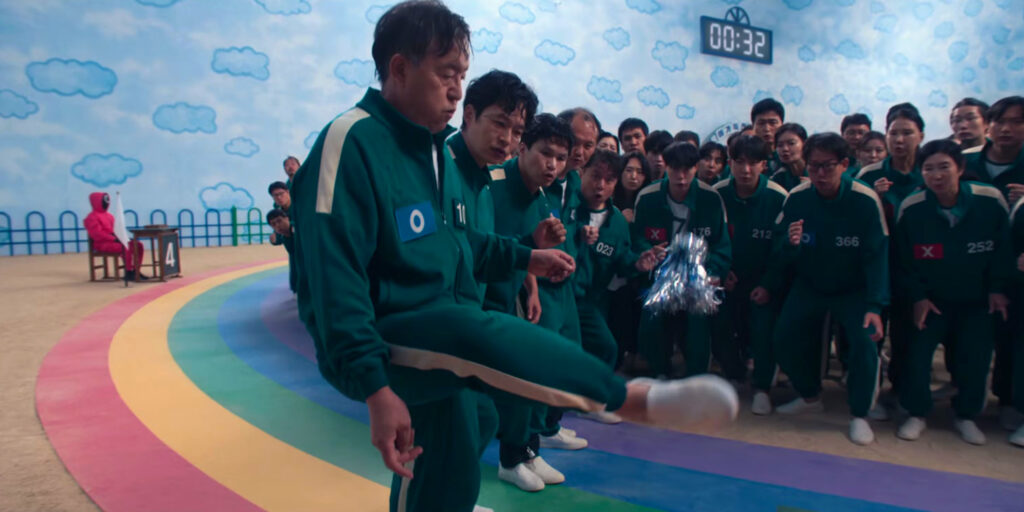
Jegi, short for Jegichagi (제기차기), is a traditional Korean game similar to hacky sack. In Squid Game, it appears as the final mini-game in the Six-Legged Pentathlon, testing both coordination and focus under pressure.
To win, the player must kick the Jegi, a weighted shuttlecock made of cloth or paper, five times in a row without letting it hit the ground. If it drops at any point, the count resets to zero.
Interestingly, Squid Game allows for a little teamwork: if the Jegi touches the fifth team member’s foot on the final kick, it still counts. This was demonstrated by Player 001 (Hwang In-ho) during the game.
Notable players who passed include Seong Gi-hun (Player 456), Lee Myung-gi (333), and Im Jeong-dae (100). Others, like Player 078 and Player 212, didn’t make it through.
Mingle
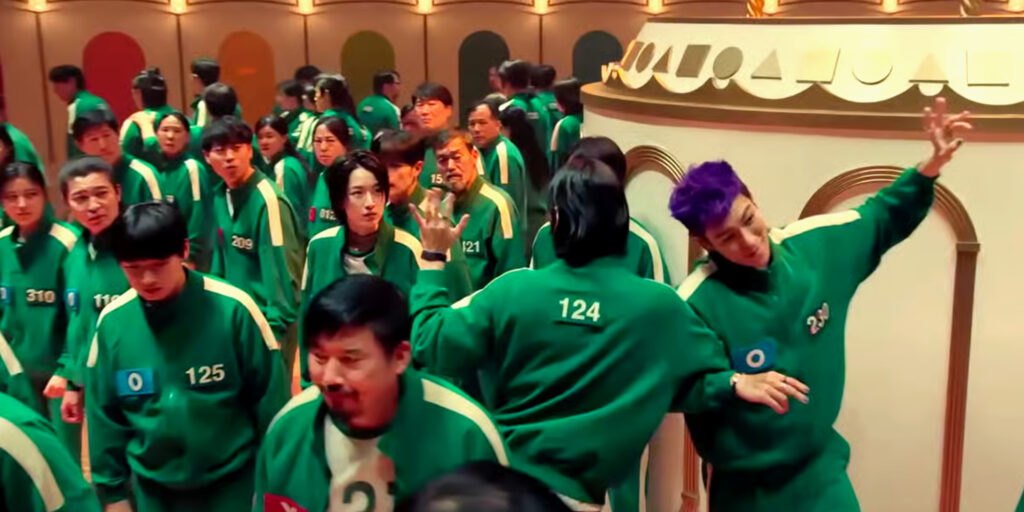
Mingle is the third game in Squid Game Season 2 and one of the most unpredictable yet. Inspired by childhood games played on school trips, it challenges players not just physically but socially.
How It Works
Players start on a rotating platform in a colorful, carnival-like arena. When the music stops, a number is called out. Players must quickly form groups of that size and enter one of the numbered rooms within 30 seconds. If a group is too small or too big, or if someone fails to find a group in time, they’re eliminated.
Each round changes the number of people required per group (e.g., 10, 4, 3, 6, 2), forcing players to constantly adjust and make fast decisions. With pressure mounting each round, betrayal becomes common, even among close allies.
What Made It Brutal
Mingle isn’t just a race against time; it’s a social survival test. Players who were once teammates in the Six-Legged Pentathlon are now competitors. Tension builds as players push, pull, and even fight their way into groups. Some are left behind. Others are thrown out of rooms. The wrong choice, or simply being too slow means death.
In total, 255 players entered the game, but only 100 survived. Major characters like Player 095 (Kim Young-mi) and Player 343 (Sim Jae-seok) were eliminated. With 155 deaths, it’s the deadliest game in Season 2 so far.
Hide and Seek
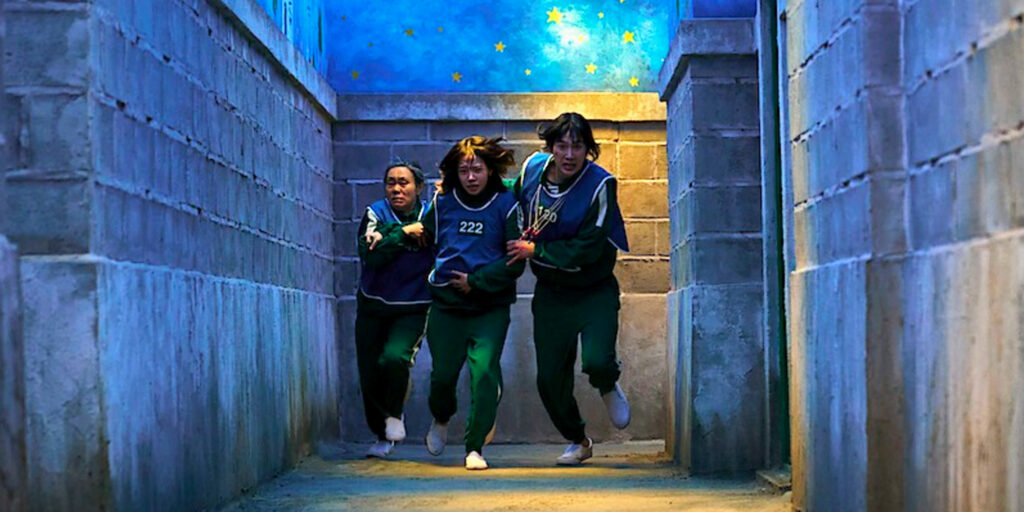
In this fourth game of Squid Game Season 2, players are randomly split into two teams, Hiders (Blue) and Seekers (Red), through a giant gumball machine. Each Hider receives a key; each Seeker, a knife. It’s a high-stakes version of a classic childhood game, played inside a dark maze lit like a starry night.
How the Game Works
- The Blue Team (Hiders) gets a 2-minute head start to explore the maze and unlock doors using their keys.
- After that, the Red Team (Seekers) is released with one goal: eliminate at least one Hider within 30 minutes.
- Hiders can try to escape through a special exit (which needs three different keys) or simply survive until time runs out.
- Seekers who fail to eliminate a Hider are executed.
- Hiders can also fight back, and many do.
Unlike earlier games, players are allowed to switch teams before the round begins, but only if both parties agree.
What Makes It Intense
With limited time and space, the maze becomes a battleground. As doors unlock, hiding spots disappear. Seekers are under pressure to kill. Hiders are desperate to survive or escape. Some players work together. Others betray without warning.
Major characters, including Park Mi-hwa (006), Seon-nyeo (044), and Cho Hyun-ju (120), don’t make it out alive. One especially brutal moment features Seong Gi-hun (456) strangling Kang Dae-ho (388). And despite finding the exit, Cho Hyun-ju turns back to help her teammates, only to be killed.
Behind the Game
- The maze is filled with children’s drawings, adding eerie contrast to the violence.
- The “Congratulations Room” exit plays upbeat music but is never shown onscreen—it’s rumored to just be a wall.
- The game mirrors a nostalgic scene from Korean childhood: playing outdoors at sunset and racing home before dark.
- According to the director, it’s a symbol of survival at night in a dangerous world.
Jump Rope

The fifth game in Squid Game Season 3 puts a brutal twist on a playground favorite. Players face a rotating metal rope and a narrow railroad-themed bridge, all set above a floral pit with Young-hee and Cheol-su watching.
How the Game Works
Players must cross a narrow bridge in under 20 minutes, all while jumping over a spinning metal rope that speeds up over time. Midway through the bridge, there’s a broken section they must leap over. Timing, balance, and teamwork become key. There’s no set order, players choose when to go.
If someone mistimes their jump or loses balance, they fall into the abyss below. Some players even push others off to improve their chances of surviving.
Notable Moments
- Player 096 is knocked off while attacking Gi-hun.
- Player 124 dies trying to retrieve a cross necklace.
- Kim Jun-hee (222) chooses not to cross, handing over her baby to Gi-hun, who carries the infant across safely.
- Player 203 and 349 both shove others off the bridge, showing how competitive it gets when the rope speeds up.
Behind the Scenes
- The rope’s movement was added with CGI for safety, though the dolls’ lower halves were real.
- The traditional Korean rhyme sung by the dolls mimics the jump rope steps: entering, turning, touching the ground, hopping, and leaving.
- According to the director, the scene is a metaphor for Young-hee visiting Cheol-su’s house, a simple journey made deadly in the Squid Game world.
Sky Squid Game: The Final Fall
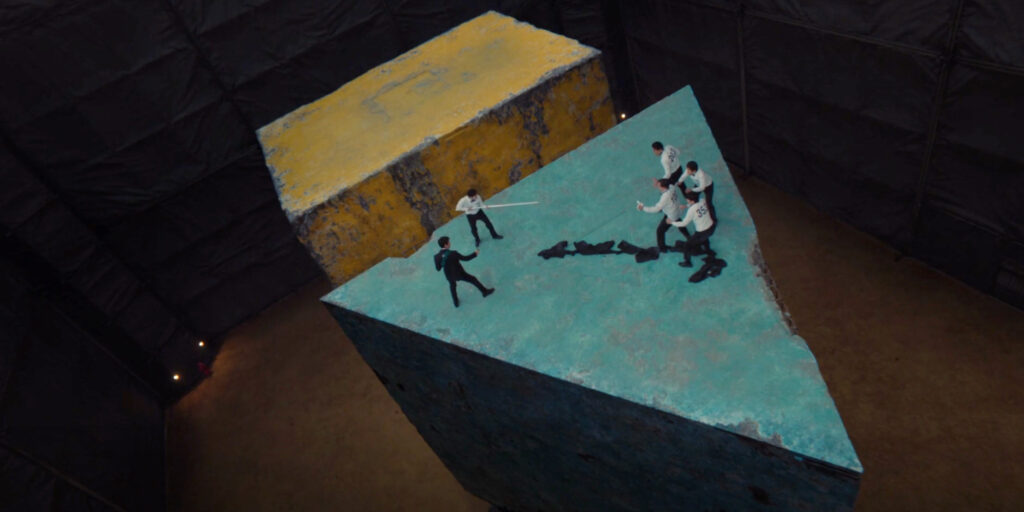
The sixth and last challenge of the 37th Squid Game is a heart-pounding twist on the classic Squid Game, played not on the ground, but high in the sky.
How It Works
Players start on one of three tall buildings shaped like a square, triangle, or circle. To begin, someone on each building must press a button on the floor. Once activated, players have 15 minutes to eliminate at least one person. If no one is eliminated in time, everyone dies.
Once someone is eliminated, a bridge appears allowing players to move to the next building. This continues through three rounds: Square → Triangle → Circle.
There’s a catch, eliminations only count after the game officially starts (i.e., after the button is pressed).
Round 1 – Square
A group of survivors—including Players 456 (Gi-hun), 100, 333, and others—discuss strategy. Eventually, Player 333 (Lee Myung-gi) kills Player 125 (Park Min-su), and the bridge to the triangle building appears.
Round 2 – Triangle
The group now plans to eliminate Player 222, an infant held by Gi-hun. But since the baby can’t be killed while in his arms, the group attempts to split them up.
Tensions explode. Player 336 (Lee Seung-won) attacks Gi-hun, who retaliates with a knife. Player 333 pushes 336 off the building, eliminating him.
Then chaos follows:
- Player 333 reveals 222 is his daughter, shocking the others.
- Player 353 is kicked off by 333.
- Player 203 attacks but is killed by Gi-hun.
- Player 100 begs for his life, offering money, but is impaled by 333.
- Player 039, overwhelmed, jumps off himself.
Only Gi-hun, 333, and baby 222 remain.
Round 3 – Circle
This is the final stage. One person must still be eliminated.
Player 333 tries to force Gi-hun to abandon the baby. The two fight. Both nearly fall, but Gi-hun holds on and 333 slips and dies.
However, the game hadn’t started on the circle yet, so 333’s death doesn’t count. Gi-hun, now alone with baby 222, presses the button, then jumps off, sacrificing himself. He declares:
“We are not horses. We are humans. And humans are…”
His final act allows the baby to win the Squid Game.


